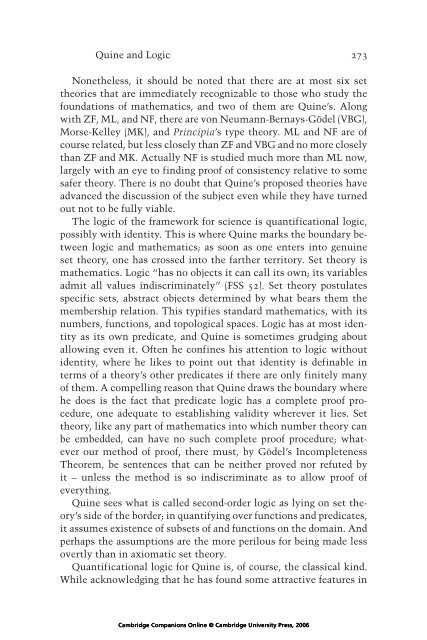Willard Van Orman Quine
Willard Van Orman Quine
Willard Van Orman Quine
You also want an ePaper? Increase the reach of your titles
YUMPU automatically turns print PDFs into web optimized ePapers that Google loves.
<strong>Quine</strong> and Logic 273<br />
Nonetheless, it should be noted that there are at most six set<br />
theories that are immediately recognizable to those who study the<br />
foundations of mathematics, and two of them are <strong>Quine</strong>’s. Along<br />
with ZF, ML, and NF, there are von Neumann-Bernays-Gödel (VBG),<br />
Morse-Kelley (MK), and Principia’s type theory. ML and NF are of<br />
course related, but less closely than ZF and VBG and no more closely<br />
than ZF and MK. Actually NF is studied much more than ML now,<br />
largely with an eye to finding proof of consistency relative to some<br />
safer theory. There is no doubt that <strong>Quine</strong>’s proposed theories have<br />
advanced the discussion of the subject even while they have turned<br />
out not to be fully viable.<br />
The logic of the framework for science is quantificational logic,<br />
possibly with identity. This is where <strong>Quine</strong> marks the boundary between<br />
logic and mathematics; as soon as one enters into genuine<br />
set theory, one has crossed into the farther territory. Set theory is<br />
mathematics. Logic “has no objects it can call its own; its variables<br />
admit all values indiscriminately” (FSS 52). Set theory postulates<br />
specific sets, abstract objects determined by what bears them the<br />
membership relation. This typifies standard mathematics, with its<br />
numbers, functions, and topological spaces. Logic has at most identity<br />
as its own predicate, and <strong>Quine</strong> is sometimes grudging about<br />
allowing even it. Often he confines his attention to logic without<br />
identity, where he likes to point out that identity is definable in<br />
terms of a theory’s other predicates if there are only finitely many<br />
of them. A compelling reason that <strong>Quine</strong> draws the boundary where<br />
he does is the fact that predicate logic has a complete proof procedure,<br />
one adequate to establishing validity wherever it lies. Set<br />
theory, like any part of mathematics into which number theory can<br />
be embedded, can have no such complete proof procedure; whatever<br />
our method of proof, there must, by Gödel’s Incompleteness<br />
Theorem, be sentences that can be neither proved nor refuted by<br />
it – unless the method is so indiscriminate as to allow proof of<br />
everything.<br />
<strong>Quine</strong> sees what is called second-order logic as lying on set theory’s<br />
side of the border; in quantifying over functions and predicates,<br />
it assumes existence of subsets of and functions on the domain. And<br />
perhaps the assumptions are the more perilous for being made less<br />
overtly than in axiomatic set theory.<br />
Quantificational logic for <strong>Quine</strong> is, of course, the classical kind.<br />
While acknowledging that he has found some attractive features in<br />
Cambridge Companions Online © Cambridge University Press, 2006
















